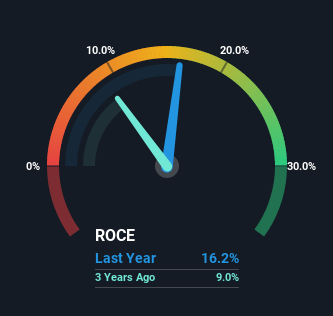Returns On Capital At Renishaw (LON:RSW) Paint A Concerning Picture
If you're looking for a multi-bagger, there's a few things to keep an eye out for. Typically, we'll want to notice a trend of growing return on capital employed (ROCE) and alongside that, an expanding base of capital employed. Basically this means that a company has profitable initiatives that it can continue to reinvest in, which is a trait of a compounding machine. Although, when we looked at Renishaw (LON:RSW), it didn't seem to tick all of these boxes.
What Is Return On Capital Employed (ROCE)?
For those that aren't sure what ROCE is, it measures the amount of pre-tax profits a company can generate from the capital employed in its business. Analysts use this formula to calculate it for Renishaw:
Return on Capital Employed = Earnings Before Interest and Tax (EBIT) ÷ (Total Assets - Current Liabilities)
0.16 = UK£145m ÷ (UK£999m - UK£102m) (Based on the trailing twelve months to December 2022).
So, Renishaw has an ROCE of 16%. In absolute terms, that's a satisfactory return, but compared to the Electronic industry average of 11% it's much better.
View our latest analysis for Renishaw
Above you can see how the current ROCE for Renishaw compares to its prior returns on capital, but there's only so much you can tell from the past. If you'd like, you can check out the forecasts from the analysts covering Renishaw here for free.
How Are Returns Trending?
When we looked at the ROCE trend at Renishaw, we didn't gain much confidence. To be more specific, ROCE has fallen from 24% over the last five years. On the other hand, the company has been employing more capital without a corresponding improvement in sales in the last year, which could suggest these investments are longer term plays. It's worth keeping an eye on the company's earnings from here on to see if these investments do end up contributing to the bottom line.
Our Take On Renishaw's ROCE
To conclude, we've found that Renishaw is reinvesting in the business, but returns have been falling. Since the stock has declined 30% over the last five years, investors may not be too optimistic on this trend improving either. Therefore based on the analysis done in this article, we don't think Renishaw has the makings of a multi-bagger.
If you're still interested in Renishaw it's worth checking out our FREE intrinsic value approximation to see if it's trading at an attractive price in other respects.
While Renishaw may not currently earn the highest returns, we've compiled a list of companies that currently earn more than 25% return on equity. Check out this free list here.
Have feedback on this article? Concerned about the content? Get in touch with us directly. Alternatively, email editorial-team (at) simplywallst.com.
This article by Simply Wall St is general in nature. We provide commentary based on historical data and analyst forecasts only using an unbiased methodology and our articles are not intended to be financial advice. It does not constitute a recommendation to buy or sell any stock, and does not take account of your objectives, or your financial situation. We aim to bring you long-term focused analysis driven by fundamental data. Note that our analysis may not factor in the latest price-sensitive company announcements or qualitative material. Simply Wall St has no position in any stocks mentioned.
Join A Paid User Research Session
You’ll receive a US$30 Amazon Gift card for 1 hour of your time while helping us build better investing tools for the individual investors like yourself. Sign up here

